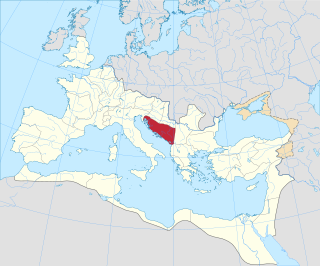Related Research Articles
Publius Metilius Nepos was a Roman senator during the late 1st century. He is known to have been suffect consul in the nundinium of September to December 91, and was appointed Governor of Britannia by the Emperor Domitian before his death, and held the post until 98.
Marcus Hordeonius Flaccus was a Roman senator who lived during the first century. He was suffect consul for the nundinium of March to April 47 as the colleague of Gaius Calpetanus Rantius Sedatus, and later commander of the Rhine army during the Batavian rebellion.
Marcus Annius Libo was a Roman Senator active in the early second century AD. He was consul in 128 as the colleague of Lucius Nonius Calpurnius Torquatus Asprenas. Libo was the paternal uncle of the Emperor Marcus Aurelius.
Publius Cornelius Lentulus Scipio was a Roman senator active during the Principate. He was suffect consul in the nundinium of July-December AD 24, as the colleague of Gaius Calpurnius Aviola. His name combines the two most famous branches of the gens Cornelia, the Lentuli and the Scipiones.

Dalmatia was a Roman province. Its name is derived from the name of an Illyrian tribe called the Dalmatae, which lived in the central area of the eastern coast of the Adriatic Sea. It encompassed the northern part of present-day Albania, much of Croatia, Bosnia and Herzegovina, Montenegro, Kosovo and Serbia, thus covering an area significantly larger than the current Croatian region of Dalmatia. Originally this region was called Illyria or Illyricum.

Gaius Julius Quadratus Bassus was a Roman senator and general. He rose from provincial aristocratic origins to occupy the highest offices of Rome. He served as a legionary commander and as imperial governor of Judea, Cappadoccia, Galatia, Syria and Dacia. He is known to have been active under Trajan in the Dacian and Parthian Wars. Bassus was suffect consul in the nundinium of May to August 105 with Gnaeus Afranius Dexter as his colleague.
Gaius Julius Cornutus Tertullus was a Roman senator who was active during the late 1st and early 2nd centuries. He is best known as the older friend of Pliny the Younger, with whom Cornutus was suffect consul for the nundinium of September to October 100.
Gaius Salvius Liberalis Nonius Bassus was a Roman senator and general, who held civil office in Britain and was a member of the Arval Brethren. He was suffect consul in the last nundinium of 85, with Cornelius Orestes as his colleague.
Gaius Caninius Rebilus was a Roman Senator, who was appointed suffect consul in 12 BC with Lucius Volusius Saturninus as his colleague.
Galus Sulpicius was a Roman Senator who was appointed suffect consul in 4 BC with Gaius Caelius as his colleague.
Quintus Marcius Barea Soranus was a Roman senator who lived in the first half of the first century AD. He was suffect consul in 34 with Titus Rustius Nummius Gallus, and proconsul of Africa from 41 to 43.

Quintus Julius Cordinus Gaius Rutilius Gallicus was a Roman senator who held several posts in the emperor's service. He was twice suffect consul: for the first time in the nundinium of September to October 70 AD; and the second time in 85 with Lucius Valerius Catullus Messalinus as his colleague, succeeding the Emperor Domitian.
Quintus Pomponius Rufus was a Roman senator active in the imperial service; he was governor during the reigns of the emperors Domitian and Trajan. Rufus was also suffect consul for the nundinium September-December AD 95 as the colleague of Lucius Baebius Tullus. Pomponius Rufus is known primarily from inscriptions.
Titus Tettienus Serenus was Roman senator of the first century. He was suffect consul in the nundinium of July to August AD 81 as the colleague of Gaius Scoedius Natta Pinarius. Serenus is primarily known from inscriptions.
Gaius Petronius was a Roman senator, who was active during the Principate. He was suffect consul from September through December AD 25, succeeding Cossus Cornelius Lentulus. Bartolomeo Borghesi has argued that Gaius Petronius is the same person as Gaius Petronius Umbrinus, who is mentioned in an inscription from Rome as curator locorum publicorum iudicandorum; this is unlikely since all known Petronii in the first half of the first century belong to the branch of the Petronii lacking a cognomen.
Gaius Laecanius Bassus was a Roman senator, who was active during the Principate. He was consul ordinarius for the year 64 with Marcus Licinius Crassus Frugi as his colleague.
Aulus Petronius Lurco was a Roman senator, who was active during the Principate. He was suffect consul in the nundinium for the second half of the year 58 with Aulus Paconius Sabinus as his colleague. He is known entirely from inscriptions.
Lucius Neratius Proculus was a Roman senator, who held several posts in the emperor's service. He was suffect consul in either the year 144 or 145. Proculus is known primarily from inscriptions.
Gaius Clodius Nummus was a Roman senator, who was active during the reign of Trajan. He was consul for the year 114 with Lucius Caesennius Sospes as his colleague. He is known almost exclusively from inscriptions.
Gaius Julius Proculus was a Roman senator, who held a number of imperial appointments during the reign of Trajan. He was suffect consul in the nundinium of May to August 109 as the colleague of Gaius Aburnius Valens. He is known entirely from inscriptions. Anthony Birley notes there is a plausible possibility that Proculus also held a second suffect consulate; any man recorded as holding a second consulate after AD 103, held it as an ordinary consul, not as a suffect consul.
References
| Political offices | ||
|---|---|---|
| Preceded by Claudius IV, and Lucius Vitellius III as ordinary consuls | Suffect consul of the Roman Empire 47 with Hordeonius Flaccus | Succeeded by Gnaeus Hosidius Geta, and Titus Flavius Sabinus as suffect consuls |